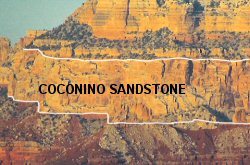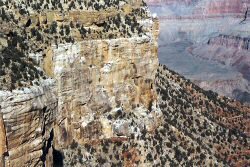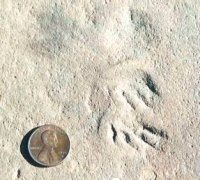*********************************************
Coconino Sandstone
Permian Period, 280 Million Years Old, 350 Feet Thick
Tan to nearly white prominent vertical cliff

The Coconino Sandstone was a Sahara-like sand sea, called an erg. It was a wind-blown dune desert that stretched from present-day Arizona all the way to Canada. Looking west from the summit of the tallest dune, perhaps you could have seen the distant shimmer of Panthalassa, the world ocean of the time of Pangaea. Look for a white or light colored cliff below the Toroweap slopes: the Coconino Sandstone is one of the most conspicuous layers. In the top of the layer, especially, there are shapes like frozen sand dunes. Tilted south, these ancient dunes reveal that the prevailing winds blew from the north.

Coconino sand grains are quartz, a mineral both abundant and durable. When rocks weather and erode, many minerals may be present in the resulting sediment. Some of these minerals dissolve; others erode to dust. Usually, after blowing in the wind for a very long time, only the sturdy quartz grains remain. These dune quartz grains are very mature: uniform composition, small sand size, very well rounded, and all grains about the same size.
Those features demonstrate the grains’ origin in blowing dunes. Sand transported by water never reaches this degree of maturity because water transports sand more slowly than wind, causing less abrasion. To turn a sediment into rock requires a natural glue: silica and calcite cements are most common. Groundwater introduces these dissolved cements into the sediment. The more cement, the harder the rock.

There are numerous reptile and invertebrate tracks in the Coconino, but no bones. For some scientists, tracks are more fascinating than bones, because they show behavior: walking, running, resting and so forth. So they give names to each distinctive trackway. The small reptile that made these tracks is called Chelichnus. No one has ever seen its bones.
The following story pretends that people were alive when this formation was laid down. But it was long before people. The purpose is to immerse ourselves in the time period--to imagine being there.
Our Tribe in Coconino Time
We have always lived in these wind-flapped tents. There is an oasis out there--we hunt reptiles and amphibians that lumber down to drink. Sometimes there are sandstorms that last three days. Then we tell each other the long stories of our ancestors. We rarely think about the blowing sand. Of course it is like this--always will be.